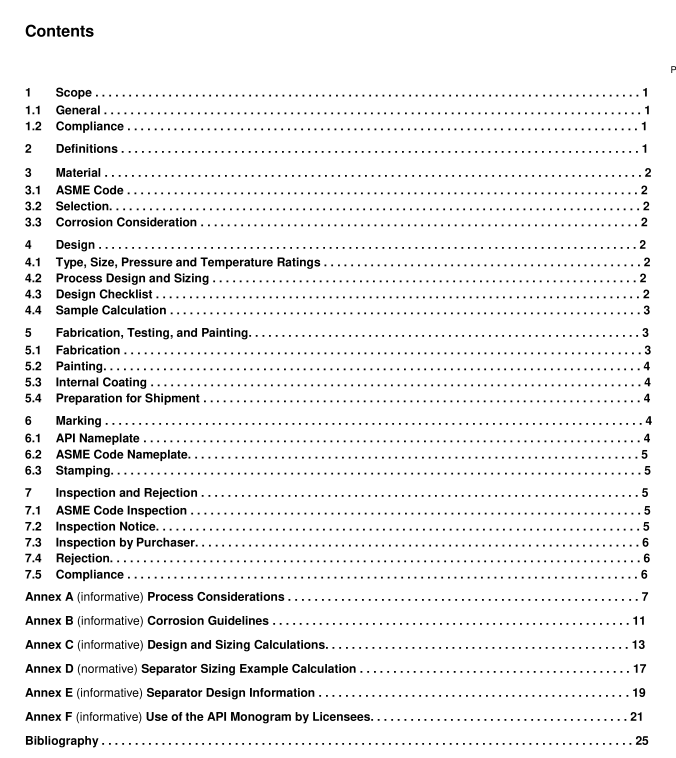API Spec 12J pdf download

API Spec 12J pdf download Specification for Oil and Gas Separators
1 Scope1.1 General
This specfication covers minimum requirements for the design, fabrication, and shop testing of oil-field type oil andgas separators and/or oil-gas-water separators used in the production of oil and/or gas, and usually located but notlimited to some point on the producing flowline between the wellhead and pipeline.Separators covered by thisspecification may be vertical,spherical, or single or double barrel horizontal.
Unless otherwise agreed upon between the purchaser and the manufacturer, the jurisdiction of this specificationterminates with the pressure vessel as defined in the Scope of Section vII, Division 1 of the ASME Boiler and
Pressure Vessel Code, hereinafter referred to as the ASME Code.Pressure vessels covered by this specification arenormally classified as natural resource vessels by APl 510, Pressure Vessel Inspection Code.Separators outside thescope of this specification include centrifugal separators, flter separators,and de-sanding separators.
1.2 Compliance
Any manufacturer producing equipment or materials represented as conforming with an APl specification is
responsible for complying with all the provisions of that specification.APl does not represent, warrant or guaranteethat such products do in fact conform to the applicable APl standard or specification.
2 Definitions
The separation of gas and liquids primarily relies on physical differences in the phases. This section covers
mechanical separation of liquids and gases. A separator vessel may be referred to as a knockout, trap, scrubber,flash chamber , or expansion vessel as well as the original term. This terminology is applied regardless of shape.Generally, the following definitions are regarded as basic.
2.1
corrosion
The destruction of a metal by chemical or electrochemical reaction with its environment (see AnnexB).
2.2
free water knockout
A type of separator vessel used to separate free water from a flow stream of gas, oil, and water.
NOTE The gas and oil usually leave the vessel through the same outlet to be processed by other equipment.The water isremoved for disposal.
2.3
maximum allowable working pressureMAWP
The maximum pressure, permissible by the ASME Code, at the top of the separator in its normal operating positionfor a designated temperature.
2.4
operating pressure
The pressure in the vessel during normal operation, not to exceed the MAWP, and usually kept at a suitable levelbelow the setting of the pressure relieving devices to prevent frequent opening (see Annex A).
2.5
scrubber
A type of separator which has been designed to handle flow streams with unusually high gas-to-liquid ratios,
commonly used in conjunction with dehydrators, extraction plants, instruments, or compressors for protection fromentrained liquids.
2.6
separator
A vessel used in the field to remove wellstream liquid(s) from gas components that may be either two-phase whichremove the total liquid from the gas or three-phase which also remove free water from the hydrocarbon liquid.
2.7
total liquid knockout
A type of separator vessel used to remove the combined liquids from a gas stream.
3 Material
3.1 ASME Code
Separators furnished to this specification shall conform to the material requirements stipulated in the latest edition ofthe ASME Code.
3.2 Selection
Material selection for corrosive fluids should be selected based on a review of related APl or NACE publications formaterials that conform to 3.1.Consideration should be given to material selection as it relates to weight loss, sulphidestress cracking, chloride stress cracking, or other forms of corrosion. lt is the responsibility of the user to determinewhat consideration for corrosion should be made to the vessel during its intended life (reference ASME Code, asapplicable to corrosion). Corrosion guidelines are given in Annex B.
3.3 Corrosion Consideration
Corrosion consideration for separators furnished to this specification shall be for the pressure containing parts of thevessel only, and as can be identified as falling within the requirements of the applicable sections of the ASME Code.Corrosion considerations for vessel internals (non-pressure parts) is by mutual agreement between the purchaserand the manufacturer and not a part of this specification.
4 Design
4.1 Type, Size,Pressure and Temperature Ratings
Separators furnished to this specification may be vertical, horizontal, or spherical, and are available in sizes andMAWP ratings shown in Table 1, Table 2, and Table 3.The following tables are for nominal industry standards.Available sizes and working pressures may vary from the stated ratings. Other sizes, pressure, and temperatureratings may be furnished by agreement between purchaser and manufacturer.
4.2 Process Design and Sizing
Typical process design and sizing calculations are given in Annex C.









